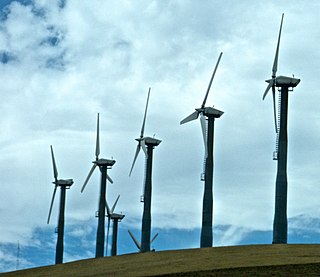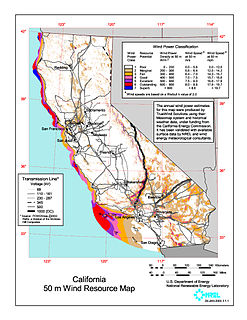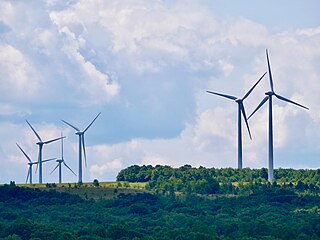
Solar Energy Generating Systems (SEGS) is a concentrated solar power plant in California, United States. With the combined capacity from three separate locations at 354 megawatt (MW), it was once the world's second largest solar thermal energy generating facility, until the commissioning of the even larger Ivanpah facility in 2014. It consisted of nine solar power plants in California's Mojave Desert, where insolation is among the best available in the United States.

The Altamont Pass wind farm is located in the Altamont Pass of the Diablo Range in Northern California. It is one of the earliest wind farms in the United States. The first wind turbines were placed on the Altamont in the early 1980s by Fayette Manufacturing Corporation on land owned by cattle rancher Joe Jess. The wind farm is composed of 4930 relatively small wind turbines of various types, making it at one time the largest wind farm in the world in terms of capacity. Altamont Pass is still one of the largest concentration of wind turbines in the world, with a capacity of 576 megawatts (MW), producing about 125 MW on average and 1.1 terawatt-hours (TWh) yearly. They were installed after the 1970s energy crisis in response to favorable tax policies for investors.

Wind power in California had initiative and early development during Governor Jerry Brown's first two terms in the late 1970s and early 1980s. The state's wind power capacity has grown by nearly 350% since 2001, when it was less than 1,700 MW. In 2016, wind energy supplied about 6.9% of California's total electricity needs, or enough to power more than 1.3 million households. Most of California's wind generation is found in the Tehachapi area of Kern County, California, with some large projects in Solano, Contra Costa and Riverside counties as well. California is among the states with the largest amount of installed wind power capacity. In recent years, California has lagged behind other states when it comes to the installation of wind power. It was ranked 4th overall for wind power electrical generation at the end of 2016 behind Texas, Iowa, and Oklahoma. As of 2019, California had 5,973 megawatts (MW) of wind power generating capacity installed.

The Wild Horse Wind Farm is a 273-megawatt wind farm that generates energy for Puget Sound Energy that consists of one hundred twenty seven 1.8-megawatt Vestas V80 turbines and twenty two 2.0-megawatt Vestas V80 turbines on a 10,800-acre (4,400 ha) site in Kittitas County, Washington, 17 miles (27 km) east of Ellensburg, Washington. The turbines are placed on the high open Shrub-steppe ridge tops of Whiskey Dick Mountain, which was chosen for its energetic wind resource, remote location, and access to nearby power transmission lines. The towers are 221 feet (67 m) tall, and each blade is 129 feet (39 m) long, with a total rotor diameter of 264 feet (80 m), larger than the wingspan of a Boeing 747. The turbines can begin producing electricity with wind speeds as low as 9 mph (14 km/h) and reach full production at 31 mph (50 km/h). They shut down at sustained wind speeds of 56 mph (90 km/h). The site is also home to one of the largest solar array (500 kW) in Washington.
Wind power in Ohio has a long history, and as of 2016, Ohio had 545 megawatts (MW) of utility-scale wind power installations installed, responsible for 1.1% of in-state electricity generated. Over 1000 MW more were under construction or pending approval. Some installations have become tourist attractions. There has been a sudden increase in generating capacity, as total wind power capacity in the state was just 9.7 MW in 2010. By 2019, there were 738 MW of capacity, which generated 1.71% of Ohio's electricity.

Making up over 55% of the state's generated electricity in 2021, wind power is the largest source of electricity generation in Iowa. In 2020, over 34 billion kWh of electrical energy was generated by wind power. As of Q3 2020, Iowa has over 10,951 megawatts (MW) of installed capacity with 5,590 wind turbines, ranking 2nd and 3rd in the nation below Texas respectively.

Biglow Canyon Wind Farm is an electricity generating wind farm facility in Sherman County, Oregon, United States. It is owned by Portland, Oregon-based Portland General Electric and began operations in 2007. With the completion of phase 3 of the project it has a generating capacity of 450 megawatts. It is located roughly five miles (8 km) northeast of Wasco, Oregon, and about ten miles (16 km) southeast of Rufus, Oregon. Biglow Canyon Wind Farm covers 25,000 acres (10,000 ha) in the Columbia River Gorge.

Wyoming has one of the highest wind power potentials of any state in the United States. As of 2016, Wyoming has 1,489 megawatts (MW) of wind powered electricity generating capacity, responsible for 9.42% of in-state electricity production. Wyoming produced of 3,800 GWh in 2015, about 9% of the total.

The Casselman Wind Power Project is a wind farm in Somerset County, Pennsylvania with 23 GE 1.5 MW Wind Turbines that began commercial operation in 2007. The wind farm has a combined total nameplate capacity of 34.5 megawatts, but actually produces about 90,666 megawatt-hours of electricity annually. The wind farm was developed by PPM Energy and constructed by Iberdrola, based in Spain. Power produced at the wind farm is distributed by First Energy.

Meadow Lake Wind Farm is an 801.25 megawatt (MW) wind farm near Brookston and Chalmers, Indiana, spreading over portions of White, Jasper, and Benton Counties. It is owned and operated by EDP Renewables North America. The facility currently has six operational phases, with 414 turbines, and is a prominent feature on both sides of Interstate 65 in western Indiana.
The Dry Lake Wind Power Project in Navajo County is the first and the largest utility-scale wind farm in the U.S. state of Arizona. Starting in 2009, it was constructed in two phases having a total generating capacity of 128.1 megawatts (MW), and is selling the electricity to the Salt River Power District (SRP).
In 2016, Arizona had 268 megawatts (MW) of wind powered electricity generating capacity, producing 0.5% of in-state generated electricity.

Alta Wind Energy Center (AWEC), also known as Mojave Wind Farm, is the third largest onshore wind energy project in the world. The Alta Wind Energy Center is a wind farm located in Tehachapi Pass of the Tehachapi Mountains, in Kern County, California. As of 2022, it is the largest wind farm in the United States, with a combined installed capacity of 1,550 MW (2,080,000 hp). The project, being developed near Tehachapi Pass Wind Farm— site of the first large-scale wind farms installed in the U.S. in the 1970s and 1980s—is "a powerful illustration of the growing size and scope of modern wind projects".
As of the end of 2016, New Mexico had 1,112 megawatts (MW) of wind powered electricity generating capacity, responsible for 11% of electricity produced that year. Wind power in New Mexico has the potential to generate more than all of the electricity consumed in the state.

Wind power in Rhode Island is in the early stages of development. There are several small scale wind turbine projects in the state. As of December 2013 there were 11 turbines at 10 sites in the state. In 2014, Rhode Island had 9 MW of installed wind power capacity, which quickly rose to 75 MW in 2019.
The Limon Wind Energy Center is a 600.6 megawatt (MW) wind farm in eastern Colorado near the town of Limon. It became the largest wind facility in the state when construction completed in 2014. The electricity is being sold to Xcel Energy under long-term power purchase agreements.
The Rush Creek Wind Project is a 600 megawatt (MW) wind facility in eastern Colorado, located south of the town of Limon. It increased the wind generating capacity in the state by 20% when it came online in late 2018. The facility is financed, owned, and operated by Xcel Energy, the largest public utility in the state. The project was developed primarily for its numerous economic benefits since Xcel previously met the minimum 30% requirement of Colorado's 2020 renewable portfolio standard.
The Spinning Spur Wind Ranch is a 516 megawatt (MW) wind farm spanning the length of southern Oldham County in the northwest panhandle region of the U.S. state of Texas. The project was developed by Cielo Wind Power and EDF Renewable Energy in three phases that came online from 2012 to 2015. Phases 2 and 3 are enabled by the Competitive Renewable Energy Zone (CREZ) transmission infrastructure completed in 2013 that was designed to bring electricity generated in energy-resource-rich western regions to industrialized population centers in the central and eastern regions of the state.










